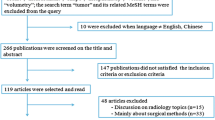Abstract
Introduction
Measuring breast volume is important to obtain satisfactory breast surgery results, and many techniques are used for this purpose. Thus, the aim of the present study was to compare 3 breast volume techniques: Pessoa’s single marking technique, magnetic resonance imaging (MRI) and Crisalix 3D software®.
Methods
Fourteen patients indicated for mammoplasty were selected. Three breast volume measurement techniques were compared: Pessoa’s single marking technique, MRI and Crisalix 3D software®. The volumes were tabulated and analyzed using R software.
Results
Average age was 30.93 ± 10.25 years. The breast volume was 1554.54 ± 512.54 cm3, as measured by the MRI technique (considered the gold standard), 1199.64 ± 403.13 cm3 using Crisalix 3D software® and 1518.04 ± 468.72 cm3 by Pessoa’s single marking technique. Comparison between the Crisalix 3D software® and MRI techniques using the pairwise t test demonstrated a statistically significant difference (t = 4.3957, df = 27, p value = 0001543), but no significant difference between the single marking and MRI techniques (t = 1.3841, df = 27, p value = 0.1777).
Conclusion
When compared to MRI, breast volume measurement using Pessoa’s single marking technique showed no statistically significant difference between them. However, the Crisalix 3D® technique exhibited a difference in relation to MRI. Anthropometric measurements are useful in measuring breast volume because they are easy to obtain, practical and inexpensive, and should be part of a plastic surgeon’s arsenal.
Level of Evidence IV
This journal requires that authors assign a level of evidence to each article. For a full description of these evidence-based medicine ratings, please refer to the Table of Contents or the online Instructions to Authors www.springer.com/00266.





Similar content being viewed by others
References
Schartzman E (1930) Die technik der mammaplastik. Chirurg 2:932
Ariê G (1957) Nova técnica em mamoplastia. Rev Latinoam Cir Plast 3:22–28
Strombeck JO (1968) Reduction mammaplasty. In: Grabb WC, Smith JW (eds) Plastic surgery. Little, Brown and Co, Boston
Pitanguy I (1966) Hipertrofias mamárias: estudo crítico da técnica pessoal. Rev Bras Cir 56:263
Skoog T (1974) Plastic surgery: new methods and refinements. Saunders, Philadelphia
Pessoa SGP, Dias IS, Pessoa LMGP (2009) Mastoplastia com marcação única: uma abordagem pessoal. Rev Bras Cir Plást 24(4):509–520
Kovacs L et al (2007) Comparison between breast volume measurement using 3D surface imaging and classical techniques. Breast 16(2):137–145
Cbulstrode N, Bellamy E, Shrotria S (2001) Breast volume assessment: comparing five different techniques. Breast 10(2):117–123
Tzou C-HJ et al (2014) Comparison of three-dimensional surface-imaging systems. J Plast Reconstr Aesthet Surg 67(4):489–497
Lejour M (1994) Vertical mammaplasty and liposuction of the breast. Plast Reconstr Surg 94(1):100–114
Killaars RC et al (2020) Clinical assessment of breast volume: can 3D imaging be the gold standard? Plastic and Reconstructive Surgery Global Open 8(11):e3236. https://doi.org/10.1097/GOX.0000000000003236
Eriksen C et al (2011) Evaluation of volume and shape of breasts: comparison between traditional and three-dimensional techniques. J Plast Surg Hand Surg 45(1):14–22
Göpper MW et al (2020) Improved accuracy of breast volume calculation from 3D surface imaging data using statistical shape models. PLoS ONE 15(11):e0233586
Itsukage S et al (2017) Breast volume measurement by recycling the data obtained from 2 routine modalities, mammography and magnetic resonance imaging. Eplasty 17:e39
Kim H et al (2015) Preoperative magnetic resonance imaging-based breast volumetry for immediate breast reconstruction. Aesthet Plast Surg 39(3):369–376
Yoo A, Minn KW, Jin US (2013) Magnetic resonance imaging-based volumetric analysis and its relationship to actual breast weight. Arch Plast Surg 40(3):203
Kayar R et al (2011) Five methods of breast volume measurement: a comparative study of measurements of specimen volume in 30 mastectomy cases. Breast Cancer Basic Clin Res 5:BCRCR2-S6128
Bulstrode N, Bellamy E, Shrotria S (2001) Breast volume assessment: comparing five different techniques. Breast 10(2):117–123
Kwong JW et al (2020) Assessing the accuracy of a 3-dimensional surface imaging system in breast volume estimation. Ann Plast Surg 84(5S):S311–S317
Vorstenbosch J, Islur A (2017) Correlation of prediction and actual outcome of three-dimensional simulation in breast augmentation using a cloud-based program. Aesthet Plast Surg 41(3):481–490
Yang J et al (2015) The three-dimensional techniques in the objective measurement of breast aesthetics. Aesthet Plast Surg 39(6):910–915
Funding
Authors' own funding.
Author information
Authors and Affiliations
Corresponding author
Ethics declarations
Conflict of interest
The authors declare that they have no conflicts of interest to disclose
Human and Animal Rights
All procedures performed in studies involving human participants were in accordance with the ethical standards of the institutional and/or national research committee and with the 1964 Helsinki declaration and its later amendments or comparable ethical standards
Informed Consent
All present participants gave their written informed consent prior to enrollment in the study.
Additional information
Publisher's Note
Springer Nature remains neutral with regard to jurisdictional claims in published maps and institutional affiliations.
Rights and permissions
Springer Nature or its licensor (e.g. a society or other partner) holds exclusive rights to this article under a publishing agreement with the author(s) or other rightsholder(s); author self-archiving of the accepted manuscript version of this article is solely governed by the terms of such publishing agreement and applicable law.
About this article
Cite this article
Markovic, A., Pessoa, S.G.P., Leite, J.A.D. et al. Assessment of Three Breast Volume Measurement Techniques: Single Marking, MRI and Crisalix 3D Software®. Aesth Plast Surg 47, 1751–1758 (2023). https://doi.org/10.1007/s00266-023-03432-w
Received:
Accepted:
Published:
Issue Date:
DOI: https://doi.org/10.1007/s00266-023-03432-w




